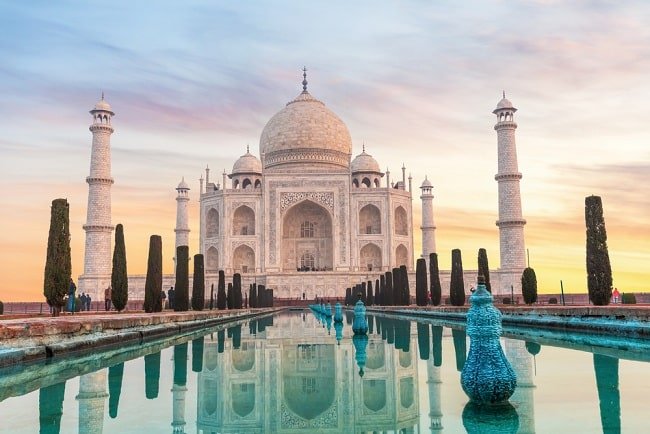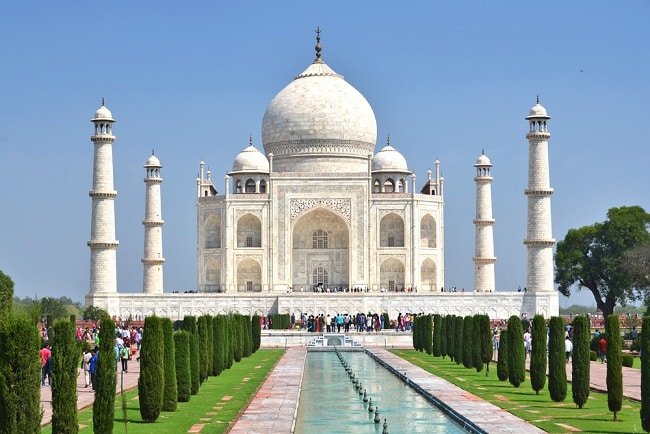5 surprising facts about the Taj Mahal in India
This complex is not only one of the symbols of Indian culture, but also evidence of a love story handed down for hundreds of years.

Here are 5 surprising facts about the Taj Mahal in India:
1. The Taj Mahal was built for love
Taj Mahal is a mausoleum built by the 5th Mughal Emperor Shah Jahan to commemorate his 3rd wife, Queen Mumtaz Mahal, so far this place has experienced hundreds of years of history.
Although at the age of 15, Emperor Shah Jahan was engaged to the then 14-year-old Queen Mumtaz Mahal, it was not until five years later that they married. At that time, Emperor Shah Jahan had two wives due to political marriage, but in the eyes of the Emperor, Queen Mahal was his only love, and other wives later on were not equal to her.
Queen Mahal died at the age of 38 in a postpartum hemorrhage that made Emperor Jahan extremely heartbroken. He decided to build the most beautiful mausoleum in the world for her to express the Emperor's longing for the Empress.
2. It took 12 years to complete the mausoleum with a large amount of manpower
The Taj Mahal is a complex complex, including gates, courtyards and mosques, covering a large area. Thousands of craftsmen participated in the construction of the Taj Mahal and more than 1,000 elephants were dispatched to provide construction materials.
The white marble dome mausoleum of the Taj Mahal took about 12 years to complete and another 10 years to complete other works.

3. Construction cost is very expensive
Because the construction of the Taj Mahal used a lot of labor and expensive construction materials from all over Asia, the cost was very expensive. These building materials include jade and crystal from China, turquoise from Tibet, slate from Afghanistan, sapphire from Sri Lanka and carnelian from Arabia etc. There are 28 kinds of gems and minerals in total. Substance is inlaid on white marble background.
When the Taj Mahal was completed in its entirety in 1653, its construction cost around 32 million Indian rupees, equivalent to about 70 billion Indian rupees today ($916 million).
4. The Taj Mahal has an extremely symmetrical design
The construction structure of the Taj Mahal is extremely symmetrical. The white mausoleum is the centerpiece of the entire complex, with two sandstone buildings on either side, a mosque and a guesthouse respectively.
In the whole complex, only the mausoleum is completely white, and the more important buildings are, the whiter they are.
5. Government of India tries to protect
Realizing the importance of the Taj Mahal, the Indian government has made every effort to protect it to prevent it from being harmed by humans or nature.
During World War II and the conflict between India and Pakistan, the Indian government built special scaffolding for the Taj Mahal to camouflage it from above.
To prevent air pollution from turning the white of the Taj Mahal into yellow, the Indian government has issued a decree banning the use of coal in factories in some neighboring areas, carbon emissions are also severely limited. strict.
- 18 unexpected facts about Taj Mahal
- The beauty of the Taj Mahal before the marble pillar collapsed
- Taj Mahal - India
- The Taj Mahal tomb turned yellow for an extremely ominous reason
- The secret rooms are locked at the Taj Mahal in India
- The sultry beauty of Taj Mahal is disappearing
- Interesting little facts about India
- Unique architecture of the semi-submersible palace floating on the lake
- Mysterious blood rain phenomenon in India
- Taj Mahal - Pearl of the Indian temple
- 4 surprising facts in the original famous fairy tales that make everyone pity
- 11 interesting facts about mustache and beard
 Chinese doctors have created medical masks that cover only the nose for convenience of eating and drinking
Chinese doctors have created medical masks that cover only the nose for convenience of eating and drinking Scientists have found a way to help you regrow new teeth after only 2 months
Scientists have found a way to help you regrow new teeth after only 2 months Do non-stick pans cause cancer? What alternatives are there?
Do non-stick pans cause cancer? What alternatives are there? Blisters around the body: Causes, symptoms and treatment
Blisters around the body: Causes, symptoms and treatment